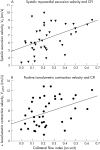Regional left ventricular function during transient coronary occlusion: relation with coronary collateral flow
- PMID: 12067939
- PMCID: PMC1767152
- DOI: 10.1136/heart.88.1.35
Regional left ventricular function during transient coronary occlusion: relation with coronary collateral flow
Abstract
Objective: To test the hypothesis that regional left ventricular (LV) function during balloon angioplasty is related to the amount of collateral flow to the ischaemic region.
Design: Prospective study.
Setting: Tertiary referral centre.
Methods: In 50 patients with coronary artery disease and without myocardial infarction, regional systolic and diastolic LV function was determined using tissue Doppler ultrasound (TD) before and at the end of a 60 second occlusion of a stenotic lesion undergoing percutaneous transluminal coronary angioplasty (PTCA) through a pressure guidewire. The study population was subdivided into a group with collaterals insufficient (n = 33) and one with collaterals sufficient (n = 17) to prevent ECG ST shifts suggestive of myocardial ischaemia during PTCA. Pulsed TD was performed from an apical window in the myocardial region supplied by the vessel being treated by PTCA. Pressure derived collateral flow index (CFI) was determined by simultaneous measurement of mean aortic (P(ao)) and distal intracoronary occlusive pressures (P(occl)), where CFI = (P(occl) - 8)/(P(ao) - 8).
Results: At 60 seconds of occlusion, several parameters of systolic and diastolic TD derived LV long axis function were significantly different between the groups. Also, there was a significant correlation between regional systolic excursion velocity, early diastolic excursion velocity, regional isovolumetric relaxation time, and CFI.
Conclusion: During brief coronary artery occlusions, regional systolic and diastolic LV function is directly related to the amount of collateral flow to this territory.
Figures






References
-
- Ball RM, Bache RJ. Distribution of myocardial blood flow in the exercising dog with restricted coronary artery inflow. Circ Res 1976;38:60–6. - PubMed
-
- Horwitz LD, Peterson DF, Bishop VS. Effect of regional myocardial ischemia on cardiac pump performance during exercise. Am J Physiol 1978;234:H157–62. - PubMed
-
- Cohen MV, Yipintsoi T. Myocardial performance and collateral flow after transient coronary occlusion in exercising dogs. Am J Physiol 1979;237:H520–7. - PubMed
-
- Schiller N, Shah P, Crawford M, et al. Recommendations for quantitation of the left ventricle by two-dimensional echocardiography. J Am Soc Echocardiogr 1989;2:358–67. - PubMed
-
- Kern MJ, Donohue TJ, Bach RG, et al. Quantitating coronary collateral flow velocity in patients during coronary angioplasty using a Doppler guidewire. Am J Cardiol 1993;71(suppl D):34–40. - PubMed
Publication types
MeSH terms
LinkOut - more resources
Full Text Sources
Medical
Miscellaneous
